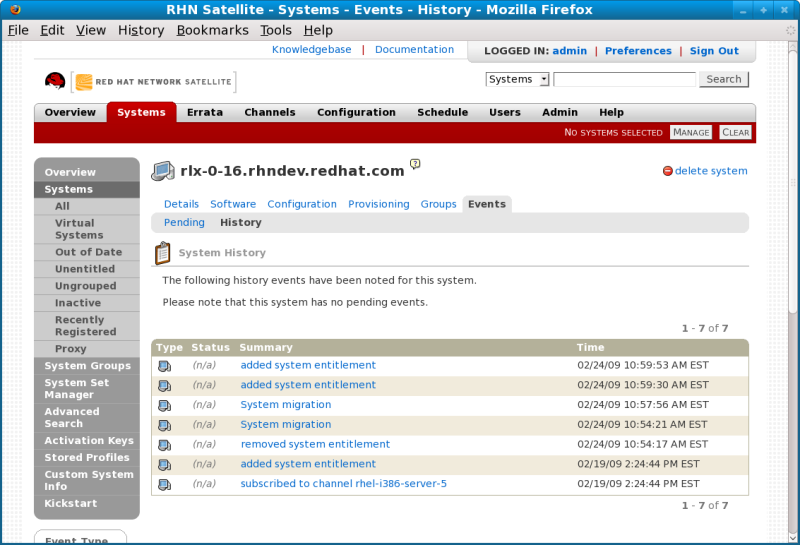9.6. Organizational Trusts
Organizations can share their resources with each other by establishing an organizational trust in the Satellite. An organizational trust is bi-directional, meaning that once a Satellite Administrator establishes a trust between two or more organizations, the Organization Administrator from each organization is free to share as much or as little of their resources as they need to. It is up to each Organization Administrator to determine what resources to share, and what shared resources from other organizations in the trust to use.
Note
Only Organization Administrators are able to share their custom content; Satellite Administrators only allocate system and software entitlements to each organization.
9.6.1. Establishing an Organizational Trust
Copy linkLink copied to clipboard!
A Satellite Administrator can create a trust between two or more organizations. To do this, click the Organizations link on the side menu on the Admin main page.
Click the name of one of the organizations and within the Details page, click the Trusts subtab.
On the Trusts subtab, there is a listing of all the other trusts on the RHN Satellite. Here you may use the Filter by Organization text box to narrow down a long list of organizations to a specific subset.
Figure 9.5. Organizational Trusts
Click the checkbox next to the names of the organizations you want to be in the organizational trust with the current organization and click the button.
9.6.3. Migrating Systems from One Trusted Organization to Another
Copy linkLink copied to clipboard!
In addition to sharing software channels, organizations in a trust can migrate systems to other trusted organizations by using a utility called
migrate-system-profile.
migrate-system-profile usage is based on the command-line, and uses systemIDs and orgIDs as arguments to specify what what is being moved and its destination organization.
To use the
migrate-system-profile command, you must have the spacewalk-backend-tools package installed. You do not need to be logged into the Satellite server to use migrate-system-profile; however, if you do not you will need specify the hostname or IP address of the server as a command-line switch.
Note
When an organization migrates a system with the
migrate-system-profile command, the system does not carry any of the previous entitlements or channel subscriptions from the source organization. However, the system's history is preserved, and can be accessed by the new Organization Administrator in order to simplify the rest of the migration process, which includes subscribing to a base channels and granting entitlements.
9.6.3.1. Using migrate-system-profile
Copy linkLink copied to clipboard!
Using
migrate-system-profile is straightforward. You need to ascertain the ID of the system to be migrated, the ID of the organization the system will migrate to, and the hostname or IP address of the Satellite server if you are running the command from another machine.
The usage from the command line is the following:
migrate-system-profile --satellite {SATELLITE HOSTNAME OR IP} --systemId={SYSTEM ID} --to-org-id={DESTINATION ORGANIZATION ID}
migrate-system-profile --satellite {SATELLITE HOSTNAME OR IP} --systemId={SYSTEM ID} --to-org-id={DESTINATION ORGANIZATION ID}
For example, if the Finance department (created as an organization in RHN Satellite with OrgID 2) wants to migrate a workstation (with SystemID 10001020) from the Engineering department, but the Finance Organization Administrator does not have shell access to the RHN Satellite server. The RHN Satellite hostname is satserver.example.com.
The Finance Organization Administrator would type the following from a shell prompt:
migrate-system-profile --satellite satserver.example.com --systemId=10001020 --to-org-id=2
migrate-system-profile --satellite satserver.example.com --systemId=10001020 --to-org-id=2
The Finance Organization Administrator is then prompted for their username and password (unless they specified it using
--username= and --password= at the command-line).
The Finance Organization Administrator would then be able to see the system from the Systems page when logged into the RHN Satellite web interface. The Finance Organization Administrator can then finish the migration process by assigning a base channel and granting entitlements to the client as he would any other system registered to his organization, which is avaiable from the system's History page in the Events subtab.
Figure 9.6. System History
Note
The Satellite Administrator can migrate a system from one trusted organization to any other in the trust. However, Organization Administrators can only migrate a system from their own organization to another in the trust.
Satellite Administrators that need to migrate several systems at once can use the
--csv option of migrate-system-profile to automate the process using a simple comma-separated list of systems to migrate.
A line in the CSV file should contain the ID of the system to be migrated as well as destination organization's ID in the following format:
systemId,to-org-id
systemId,to-org-id
the
systemId, for example could be 1000010000, while the to-org-id could be 4. So, a compatible CSV could look like the following:
1000010000,3 1000010020,1 1000010010,4
1000010000,3
1000010020,1
1000010010,4
For more information about using
migrate-system-profile refer to the manual page by typing man migrate-system-profile or for a basic help screen type migrate-system-profile -h.

